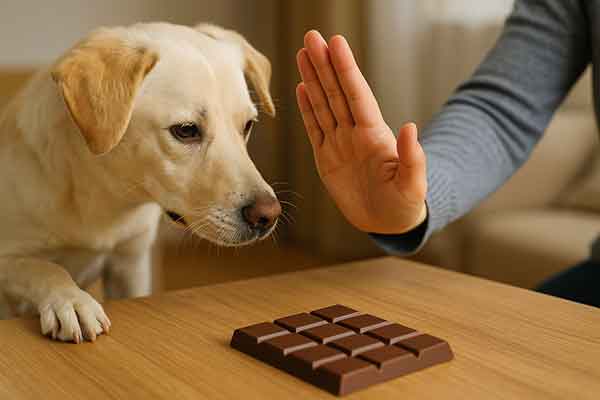Is Chocolate Toxic to Dogs? | What Every Dog Owner Should Know
It’s a common and well-meaning mistake—sharing a treat with your furry friend. But when that treat is chocolate, it can be far from harmless. If you’ve ever wondered, “Is chocolate toxic to dogs?”, the answer is a firm yes. Chocolate contains ingredients that can be extremely dangerous to dogs, and in some cases, even fatal. This guide will help you understand why chocolate is toxic, what symptoms to watch for, and what immediate actions to take if your dog eats chocolate.
Table of Contents
- Why Is Chocolate Toxic to Dogs?
- How Much Chocolate Is Toxic to Dogs?
- Types of Chocolate and Their Toxicity
- Symptoms of Chocolate Poisoning in Dogs
- What to Do If Your Dog Eats Chocolate
- Veterinary Treatment Options
- How to Prevent Chocolate Toxicity in Dogs
- Frequently Asked Questions
Why Is Chocolate Toxic to Dogs?
Chocolate contains two ingredients that are harmful to dogs: theobromine and caffeine. Both are stimulants that belong to a class of chemicals called methylxanthines. Dogs metabolize these substances much more slowly than humans, making them highly susceptible to their toxic effects.
Theobromine affects the central nervous system and cardiovascular system, causing symptoms ranging from restlessness to seizures. Even a small amount of chocolate can lead to serious issues depending on the dog’s size and the type of chocolate consumed.
How Much Chocolate Is Toxic to Dogs?
The toxic dose of theobromine is approximately 20 mg per kilogram of a dog’s body weight. Doses above 40 mg/kg can cause cardiac symptoms, while doses over 60 mg/kg can result in seizures and potentially death.
Here’s a general guide based on dog size and chocolate type:
- Small dog (10 lbs): As little as 1 ounce of dark chocolate can be dangerous
- Medium dog (30 lbs): Around 2–3 ounces of milk chocolate can cause issues
- Large dog (70+ lbs): Larger quantities are needed, but still risky
It’s always safest to call your vet, regardless of how much chocolate was consumed.
Types of Chocolate and Their Toxicity Levels
Different types of chocolate contain different levels of theobromine:
- White Chocolate: Lowest theobromine content, but still not recommended
- Milk Chocolate: Moderate theobromine levels, can be toxic in larger amounts
- Dark Chocolate: High levels of theobromine, very toxic even in small doses
- Baking Chocolate/Cocoa Powder: Extremely high theobromine concentration—most dangerous
The darker and more bitter the chocolate, the more dangerous it is to dogs.

Symptoms of Chocolate Poisoning in Dogs
Symptoms usually begin 6 to 12 hours after ingestion and can last for up to 72 hours. Common signs include:
- Vomiting or diarrhea
- Excessive thirst and urination
- Hyperactivity or restlessness
- Panting or elevated heart rate
- Tremors or seizures
- Muscle rigidity
- In severe cases, coma or death
If you notice any of these symptoms, seek veterinary help immediately.
What to Do If Your Dog Eats Chocolate
Time is critical. If your dog has consumed chocolate:
- Estimate the amount and type of chocolate ingested
- Note your dog’s weight
- Contact your veterinarian or an emergency vet clinic immediately
- Do not induce vomiting unless directed by a vet
Even if your dog isn’t showing symptoms, it’s better to err on the side of caution.
Veterinary Treatment Options
Treatment will depend on how much time has passed and the severity of symptoms. Possible options include:
- Inducing vomiting: Safe only within 1–2 hours of ingestion
- Activated charcoal: Prevents further absorption of theobromine
- IV fluids: Support kidney function and aid in toxin elimination
- Medications: To control heart rate, seizures, or tremors
- Monitoring: Dogs may need to be hospitalized for observation and care
With prompt treatment, most dogs recover fully from chocolate poisoning.
How to Prevent Chocolate Toxicity in Dogs
Preventing chocolate ingestion is the best form of protection. Here’s how to keep your dog safe:
- Store chocolate securely in high cabinets or containers
- Educate children and guests about not feeding chocolate to dogs
- Be extra cautious during holidays like Halloween, Christmas, and Valentine’s Day
- Supervise parties and gatherings where chocolate might be within reach
- Keep an emergency vet number handy at all times
Frequently Asked Questions
Is chocolate always toxic to dogs?
Yes. Even though toxicity depends on the amount and type, chocolate is never safe for dogs to consume.
Can a small amount of chocolate kill a dog?
In small dogs, even a small amount of dark or baking chocolate can be fatal. Always consult your vet immediately.
What if my dog ate chocolate but seems fine?
Symptoms can take hours to appear. It’s crucial to contact your vet immediately for advice, even if your dog looks okay.
How long after eating chocolate will my dog get sick?
Most dogs show symptoms within 6–12 hours, but early intervention is key to successful treatment.
Can dogs eat chocolate alternatives like carob?
Yes! Carob is a safe, dog-friendly alternative to chocolate and is often used in dog treats.
Conclusion
So, is chocolate toxic to dogs? Absolutely. While a bite of chocolate may seem harmless, it can have serious—and sometimes fatal—effects on your dog’s health. Always keep chocolate out of reach, act quickly if ingestion occurs, and educate your household on the dangers. By staying informed and prepared, you can ensure your pup stays safe, healthy, and chocolate-free.

